This post may contain affiliate links. Please read our disclosure policy.
Soft and fluffy chiffon cake infused with the tropical aroma of mango. This is one of the great ways to use mangoes when they are in season.
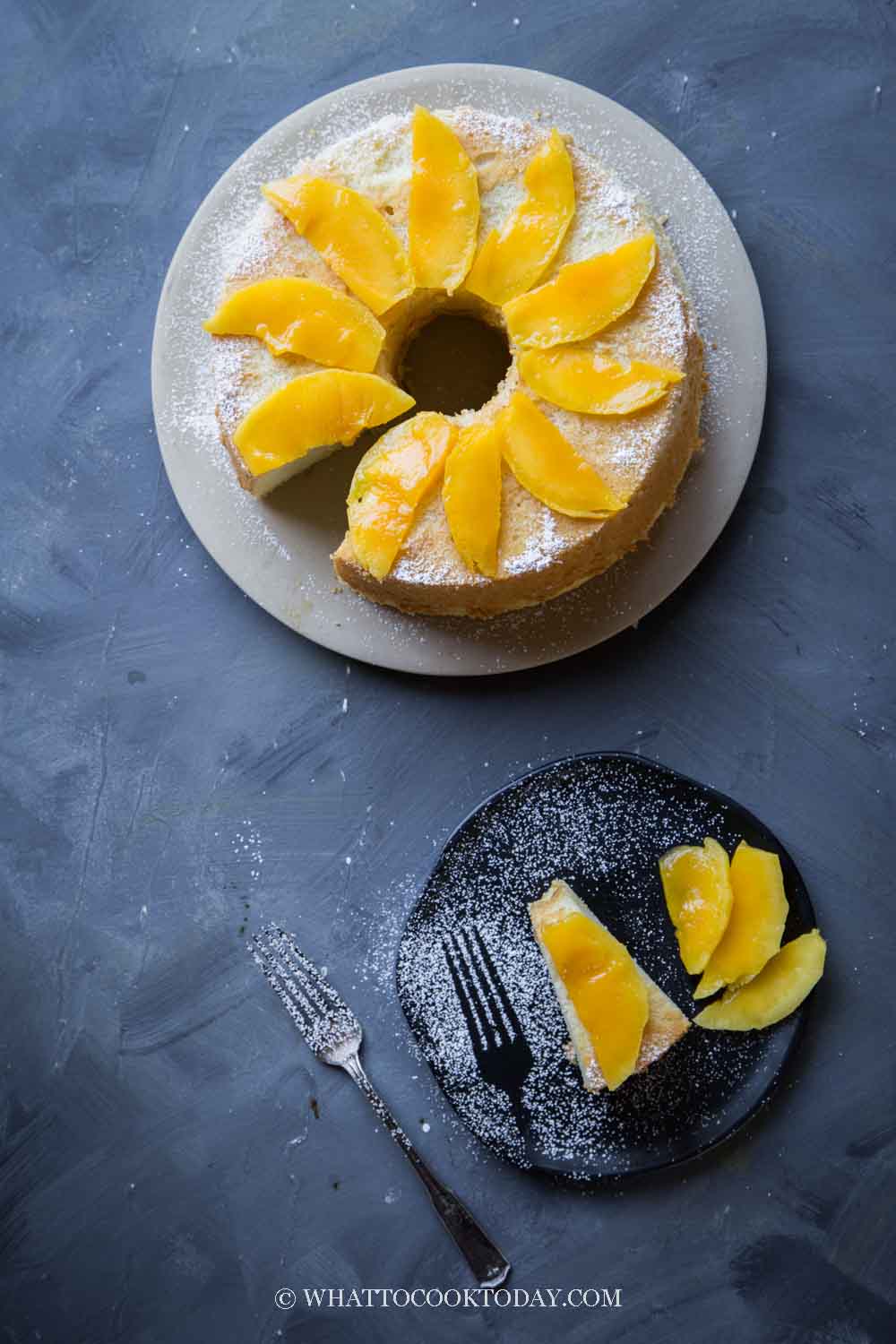
When mango season is in a full swing, I always thought of ways to incorporate them into desserts. Chiffon cake is like a blank canvas that I like to use to incorporate different flavor. This mango chiffon cake is so soft, fluffy, and with great mango flavor. No artificial flavoring is used. You are welcomd to add mango extract (if you have any) to amplify it, but even without it, you will notice the mango flavor in the cake.
How to make soft and fluffy mango chiffon cake
1. Puree the mango in a food processor or a blender until smooth
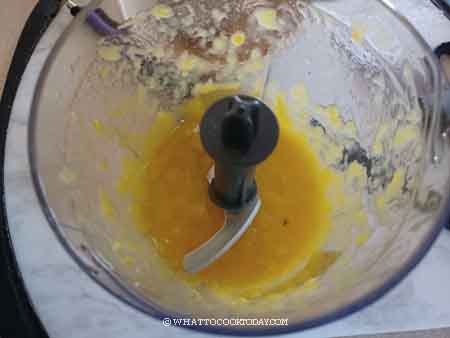
2. In a separate bowl, whisk the egg yolks, sugar and cooking oil, then add milk and mango puree
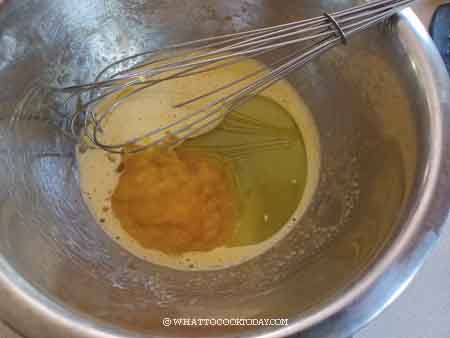
3. Sift in the cake flour and salt into the batter. Whisk to mix into a smooth batter. Set aside
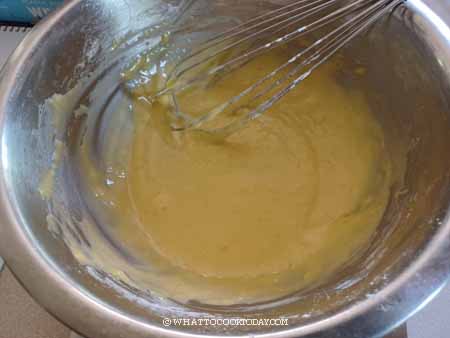
4. Beat the egg whites on medium speed until frothy, add cream of tartar or lemon juice/vinegar and whip until it turns whitish and air bubbles are fine. Gradually add the sugar as you beat, in 3 batches. I beat them at medium speed (speed 6 on Kitchen Aid). This will take a bit longer compared to beating at high speed. I used to do higher speed (speed 8), but the meringue is smoother and nicer when I maintain the speed on 6 and much more stable too. I highly recommend stopping several times to check on the consistency and scraping the sides of the bowl to make sure no sugar is left on the side of the bowl.
Whip until you reach a stiff peak but still have a slight bent on the tip. Then lower the speed to 4 and whip for 1 minute to even out large bubbles and stop beating
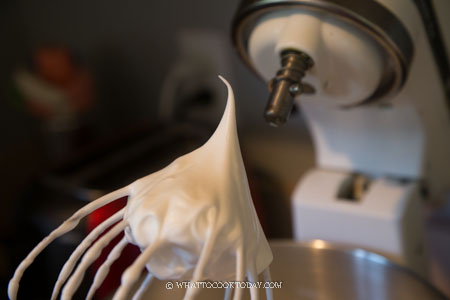
5. Gently fold 1/3 of the meringue into the thick batter. Using a whisk, using a cutting motion and fold over to mix. Repeat this motion for several rounds
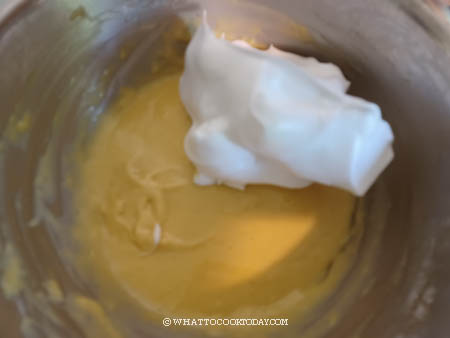
6. Continue on with the second 1/3 of the meringue again to mix

7. For the last 1/3 of the meringue, use a rubber spatula instead to ensure you get all the batter at the bottom of the bowl mixed in as well. Use a cut down in the middle and fold over motion to fold gently but quickly. Make sure you don’t see any more white meringue. The mixture should be fluffy and voluminous


8. Pour the batter into an UNGREASED chiffon cake pan. Use a rubber spatula to smooth the surface. Gently drop the cake pan from about 10 cm height on the counter 2-3 times. Use a skewer to draw a zig zag to pop bubbles inside the cake batter


9. Put the chiffon pan in the middle rack and let it bake for 50-55 minutes for 8-inch chiffon cake. The time is just for reference. Your oven may need less or more time to bake. I know this is weird to say, but it’s actually “safer” to overbake chiffon cake than underbaking. Underbaking tends to cause the cake to collapse. Usually if you insert a skewer inside the cake and no crumbs stick to it or very minimal crumbs, it is safe to say that the cake is cooked through. You can also touch the top and if it springs back, it’s a good sign that it’s cooked through. I like to have some golden brown on top. I don’t know if you notice, but when the cake has a golden brown color on top, it’s actually more flavorful too than when the cake is pale in color
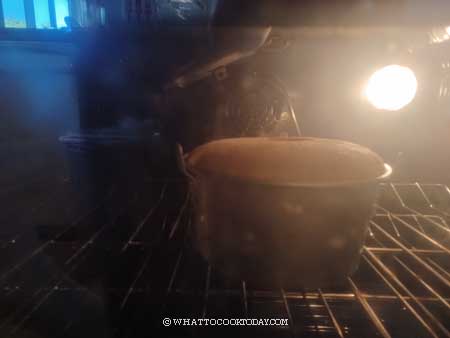
10. Drop the cake pan from about 10 cm height on the counter several times to prevent shrinkage when you pull the cake out of the oven. Then carefully invert the pan upside down immediately. Please don’t be tempted to remove it from the pan if it’s still warm. It takes about one to two hours to cool down completely

11. Once it’s cool down completely, use a spatula knife to run through the edge and the outer center of the tube to help release the cake. Gently push the base to lift the cake out. Use the knife again to run through the base of the pan and then carefully release the cake. I suggest that you wait for 24 hours before serving the cake (if you can wait). The flavor always gets better the next day compared to when you serve it on the same day
12. The cake can be served as is or you can serve it with slices of fresh mango and some whipped cream or a light dusting of icing sugar
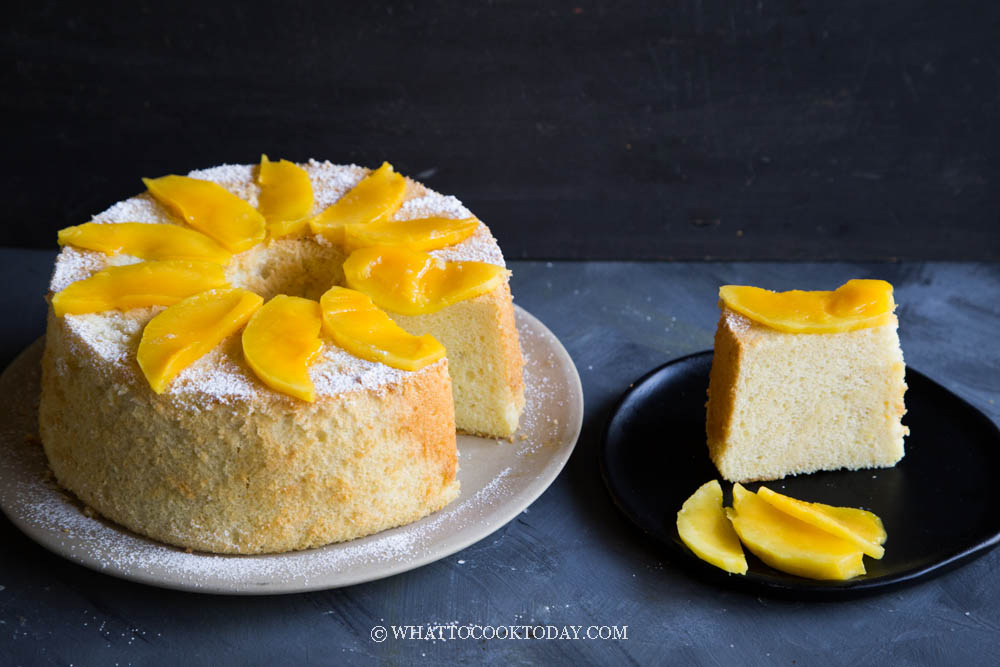
Did you make this mango chiffon cake recipe?
I love it when you guys snap a photo and tag to show me what you’ve made 🙂 Simply tag me @WhatToCookToday #WhatToCookToday on Instagram and I’ll be sure to stop by and take a peek for real!
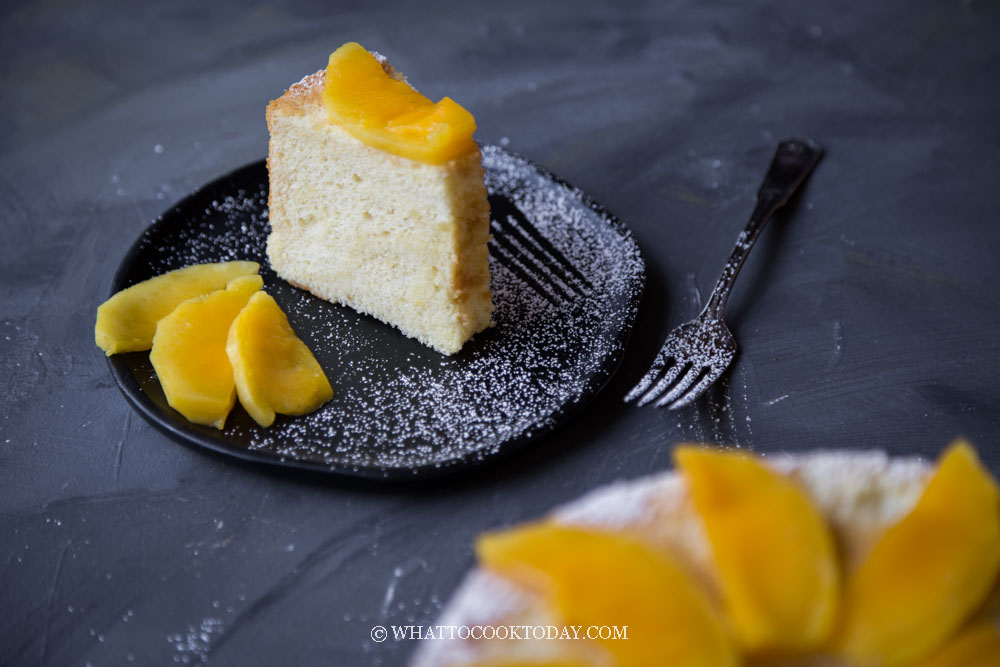
Soft Fluffy Mango Chiffon Cake
Ingredients
Cake batter:
- 5 egg yolks (room temperature) from 58-60 grams egg with the shell
- 25 gr sugar
- 70 gr oil
- 30 gr whole milk
- 100 gr mango puree
- 125 gr cake flour
- ¼ tsp salt
Meringue:
- 5 egg whites (room temperature)
- 1 tsp vinegar or 1/2 tsp cream of tartar
- 125 gr sugar
Serve with: (optional)
- Slices of fresh mango
- Whipped cream
Instructions
- Make sure your chiffon cake pan does not have a non-stick coating or your cake will not rise. The cake needs to cling to the side of the pan to rise tall
- Get the eggs out of the fridge and separate them when they are still cold. They are easier to separate when they are cold. Let the yolks and the whites come to a room temperature, this may take about 30 minutes or so
Prepare the cake batter:
- Puree the mango in a food processor or a blender until smooth
- Preheat your oven to 330 F (165 C) for conventional oven. If you have a convection oven, I suggest lowering the temperature by 20 F (15 C). Place the oven rack 4th from the top (or adjust accordingly, you will know your oven best)
- Place the egg whites in a clean mixing bowl. I use a stand mixer with a whisk attachment. You will have trouble whipping your meringue if there's a trace of grease in your utensils or bowls
- In a separate bowl, whisk the egg yolks, sugar and cooking oil, then add milk and mango puree. Sift in the cake flour and salt into the batter. Whisk to mix into a smooth batter. Set aside
Whipping the meringue:
- Beat the egg whites on medium speed until frothy, add cream of tartar or lemon juice/vinegar and whip until it turns whitish and air bubbles are fine. Gradually add the sugar as you beat, in 3 batches. I beat them at medium speed (speed 6 on Kitchen Aid)
- This will take a bit longer compared to beating at high speed. I used to do higher speed (speed 8), but the meringue is smoother and nicer when I maintain the speed on 6 and much more stable too. I highly recommend stopping several times to check on the consistency and scraping the sides of the bowl to make sure no sugar is left on the side of the bowl
- Whip until you reach a stiff peak but still have a slight bent on the tip. Then lower the speed to 4 and whip for 1 minute to even out large bubbles and stop beating
Fold meringue into the cake batter:
- Gently fold 1/3 of the meringue into the thick batter. Using a whisk, using a cutting motion and fold over to mix. Repeat this motion several rounds. Continue on with the second 1/3 of the meringue again to mix. For the last 1/3 of the meringue, use a rubber spatula instead to ensure you get all the batter at the bottom of the bowl mixed in as well. Use a cut down in the middle and fold over motion to fold gently but quickly. Make sure you don't see any more white meringue. The mixture should be fluffy and voluminous.
- Pour the batter into an UNGREASED chiffon cake pan. Use a rubber spatula to smooth the surface. Gently drop the cake pan from about 10 cm height on the counter 2-3 times. Use a skewer to draw a zig zag to pop bubbles inside the cake batter
Baking:
- Put the chiffon pan in the middle rack and let it bake for 50-55 minutes for 8-inch chiffon cake. The time is just for reference. Your oven may need less or more time to bake
Test for doneness:
- I know this is weird to say, but it's actually "safer" to overbake chiffon cake than underbaking. Underbaking tends to cause the cake to collapse. Usually if you insert a skewer inside the cake and no crumbs stick to it or very minimal crumbs, it is safe to say that the cake is cooked through. You can also touch the top and if it springs back, it's a good sign that it's cooked through. I like to have some golden brown on top. I don't know if you notice, but when the cake has a golden brown color on top, it's actually more flavorful too than when the cake is pale in color
- Don't be alarmed if your cake has some cracks on top. What you are looking at will become the bottom of your cake. I know many people mind it a lot and make a big fuss when the top of the chiffon cake cracks, but actually it's not a flaw.
Cooling:
- Drop the cake pan from about 10 cm height on the counter several times to prevent shrinkage when you pull the cake out of the oven. Then carefully invert the pan upside down immediately. Please don't be tempted to remove it from the pan if it's still warm. It takes about one to two hours to cool down completely
- Once it's cool down completely, use a spatula knife to run through the edge and the outer center of the tube to help release the cake. Gently push the base to lift the cake out. Use the knife again to run through the base of the pan and then carefully release the cake
- I suggest that you wait for 24 hours before serving the cake (if you can wait). The flavor always gets better the next day compared to when you serve it on the same day
How to store:
- Let the cake cool down completely. Store the cake in an air-tight container for up to 3 days at room temperature. Try to finish it within 3 days
To serve:
- The cake can be served as is or you can serve it with slices of fresh mango and some whipped cream or a light dusting of icing sugar


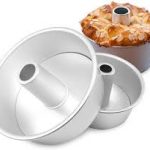

20 comments
Hi, I am from Australia, I am new to baking and would really love to try this and was wondering if you can tell me what ingredients list I should use for a 10” tube pan….0.5x, 1x, 1.5x or the 2x ? as it only changes the amount of slices but not the size of pan, that stays the same 8” tube pan.
Thank you in advance
Hi Susan, for 10″ tube pan, I would multiply the ingredients by 1.6x and round up the ingredients. You will use 8 large-size eggs (separate the yolks and whites). You may need to bake for 65-70 minutes, depending on your oven, but start checking at 1 hour mark. I hope that helps!
I have tried this recipe and this is the most successful chiffon i got out of 100’s of recipes i trued.. the texture is so soft like cloud and the perfect amount of sweetness.. Thank you Marvellina..
Can i replace mango puree with milk or something to have a basic vanilla chiffon flavor?
Hello Rama, I’m so glad the recipe worked out for you! I’m not sure if you have seen this vanilla chiffon cake recipe https://whattocooktoday.com/vanilla-chiffon-cake.html If I may suggest you to use that recipe instead for vanilla chiffon flavor. Please let me know if you have any questions, I’ll try my best to help!
Oh!! I searched for the basic one but somehow missed it.. thank you for sending me the link.. going to try all the chiffons
One more question.. do you think these chiffons can be used for tiered cakes?
Hi Rama, yes, you can use it for tiered cake. The filling can’t be too heavy though. Any filling with whipped cream-based would be more appropriate as chiffon is very airy and light. Buttercream type filling or frosting would be a bit too heavy and may weigh down the cake.
Can I use less number of eggs? If so how many?
Also, can I use 9 or 10 inches chiffon cake pan ?
Hi Ria, you need to follow the recipe for the account of eggs and the size of the pan. If you use larger size pan, the cake will be shorter and baking time will be shorter too, you may need to start checking at around 45 minutes, depending on your oven.
How much cream of tartar do you use???? I’m not seeing a measurement anywhere on this page….
I have updated the recipe accordingly.